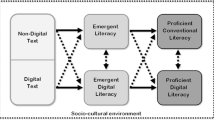Abstract
Literature-rich interactions provide strategies that help emergent readers to develop knowledge about print, including the production and recognition of letters, and generate familiarity with the basic purposes and mechanisms of reading. Yet teacher understanding of these multiple dimensions of emergent literacy does not ensure that a child will break the code and learn to read. Effective teachers, administrators, and curriculum specialists integrate a variety of information to formulate design principles and develop and implement developmentally appropriate curriculum and concomitant teaching strategies. Gunn and colleagues in the National Center to Improve the Tools of Education Report (1995) suggest this may include conspicuous strategies, scaffolding, strategic integration, primed background knowledge, and thoughtful review. The relationship among these four curriculum design strategies and developmentally appropriate literature selections are discussed. Twelve current children’s books are suggested for consideration when implementing various curriculum strategies with emergent literacy learners.
Similar content being viewed by others
References
Biondo, S., Raphael, T., & Gavelek, J. (2000). Integrated literacy instruction. In M. L. Kamil, P. B. Mosenthal, P. D. Pearson, & R. Barr (Eds.), Handbook of reading research (Vol. 3, pp. 587–608). Mahwah, NJ: Lawrence Erlbaum Associates.
Bodrova, E., & Leong, D. J. (2007). Tools of the mind: The Vygotskian approach to early childhood education (2nd ed.). Upper Saddle River, NJ: Pearson Education, Inc.
Doyle, B., & Bramwell, W. (2006). Promoting emergent literacy and social–emotional learning through dialogic reading. The Reading Teacher, 59(6), 554–564. doi:10.1207/sldrp1404_1.
Elliott, E., & Olliff, C. (2008). Developmentally appropriate emergent literacy activities for young children: Adapting the Early Literacy and Learning Model (ELLM). Early Childhood Education Journal, 35, 551–556. doi:10.1007/s10643-007-0232-1.
Epstein, A. (2007). The Intentional teacher: Choosing the best strategies for children’s learning (pp. 23–40). Washington, DC: National Association for the Education of Young Children.
Gunn, B. K., Simmons, D. C., & Kame’enui, E.J. (1995). Emergent literacy: A synthesis of the research. Eugene, OR: The National Center to Improve the Tools of Educators. Retrieved from http://idea.uoregon.edu:16080/~ncite/documents/techrep/tech19.html.
Hall, T. (2002). Explicit instruction. Wakefield, MA: National Center on Accessing the General Curriculum. Retrieved from http://www.cast.org/publications/ncac/ncac_explicit.html.
Henderson, S. D., Many, J. E., Wellborn, H. P., & Ward, J. (2002). How scaffolding nurtures the development of young children’s literacy repertoire: Insiders’ and outsiders’ collaborative understandings. Reading Research and Instruction, 41(4), 309–320.
International Reading Association (IRA) and National Association for the Education of Young Children. (1998). Joint position statement by IRA and NAEYC/learning to read and write: Developmentally appropriate practices for young children. Retrieved from http://208.118.177.216/about/positions/PSREAD0.asp .
Justice, L., Kaderavek, J., Fan, X., Sofka, A., & Hunt, A. (2009). Accelerating preschoolers’ early literacy development through classroom-based teacher-child storybook reading and explicit print referencing. Language, Speech, and Hearing Services in Schools, 40, 67–85. doi:10.10440161(2008/07-0098).
Morgan, P., & Meiers, C. (2008). Dialogic reading’s potential to improve children’s emergent literacy skills and behavior. Preventing School Failure, 53(4), 11–16. doi:10.3200/PSFL.52.4.11-16.
National Early Literacy Panel. (2008). Developing early literacy. Washington, DC: National Institute for Literacy.
Pentimonti, J., & Justice, L. (2009). Teacher’s use of scaffolding strategies during read alouds in the preschool classroom. Early Childhood Education Journal/Online First. October 8, 2008. doi:10.1007/s10643-009-0348-6.
Simmons, D. C., & Kame’enui, E. J. (1998). Emergent literacy: Instructional and curricular basics and implications. In D. C. Simmons & E. J. Kame’enui (Eds.), What reading research tells us about children with diverse learning needs: Bases and basics (pp. 51–60). New York: Taylor & Francis.
Vygotsky, L. S. (1978). Mind in society. Cambridge, MA: Harvard University Press.
Wood, D., Bruner, J. S., & Ross, G. (1976). The role of tutoring in problem solving. Journal of Child Psychology and Child Psychiatry, 17, 89–100. doi:10.1111/j.1469-7610.1976.tb00381.x.
Zeece, P. D. (2003). Growing readers: The role of early childhood professionals. Early Childhood Education Journal, 30(4), 259–263. doi:10.1023/A:1023395809759.
Author information
Authors and Affiliations
Corresponding author
Rights and permissions
About this article
Cite this article
Zeece, P.D. Curriculum Design Strategies in Emergent Literacy: The Role of Developmentally Appropriate Literature Selections. Early Childhood Educ J 37, 345–350 (2010). https://doi.org/10.1007/s10643-009-0360-x
Published:
Issue Date:
DOI: https://doi.org/10.1007/s10643-009-0360-x




